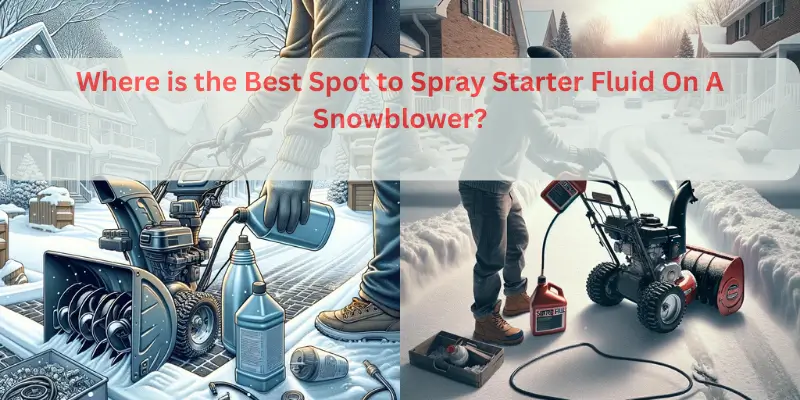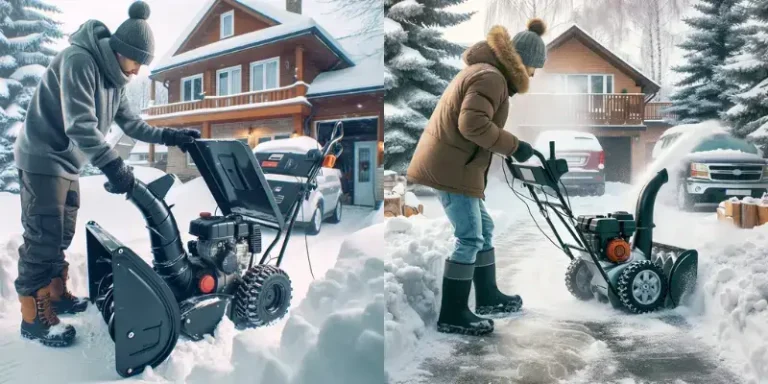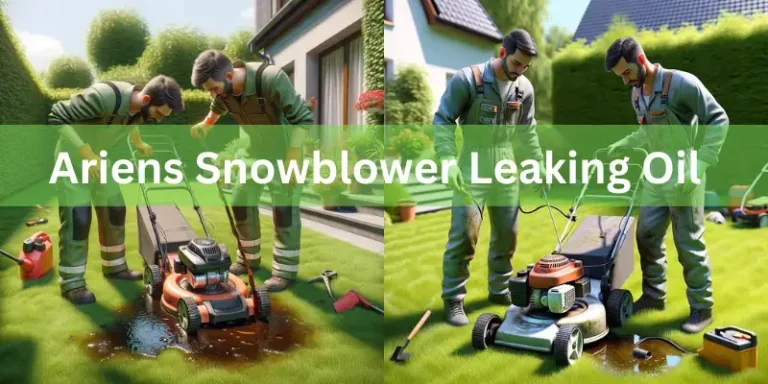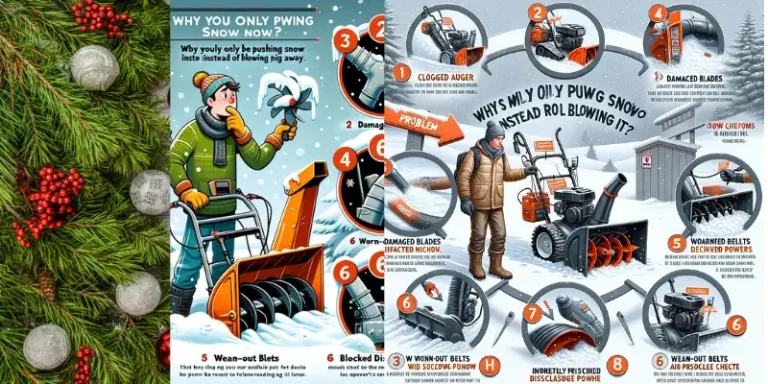Where is the Best Spot to Spray Starter Fluid On A Snowblower?
As winter unfolds its blanket of snow, it brings the joy of snow-covered landscapes and cozy nights. Yet, it also heralds the less glamorous task of snow removal.
“For those who own a snowblower, ensuring its readiness is key to a hassle-free winter. Homeowners are asking questions about “Where is the Best Spot to Spray Starter Fluid on a Snow Blower?”
Best Spot to spray starter fluid directly into the air intake duct of your snowblower; it’s the most effective spot to ensure a quick and smooth engine start.
Understanding why starter fluid is essential to your snowblower’s performance in cold conditions is the first step. Whether facing the first frost or reviving a snowblower from its summer hibernation, starter fluid is often the unsung hero, providing the necessary boost to awaken your machine.
Understanding Starter Fluid
What Is Starter Fluid?
Starter fluid is an engine-aiding chemical, primarily made of diethyl ether, formulated to facilitate quick and efficient engine startups. Its composition is tailored to ignite swiftly, making it especially effective in cold weather conditions where traditional gasoline might falter. This rapid ignition quality of starter fluid provides an essential boost, ensuring that your snowblower starts smoothly and reliably, even on the chilliest mornings.
Flammability and Safety
Starter fluid is flammable but can be safe if used right. It lights up easily, which is good in cold weather. But, you need to be careful how you handle and keep it. It’s important to not spray it near any flames or sparks.
Good airflow is needed to stop fumes from building up and causing a fire. Store the fluid in a cool, dry spot, away from sun and heat, to keep it safe and working well.
Use the fluid carefully. Too much can flood or harm your engine. A quick, small spray into the air intake is enough to help start the engine. Follow these safety tips to use starter fluid safely. This way, your snowblower will work well all winter.
When to Use Starter Fluid?
Cold Weather Starting
In winter, starting a snowblower can be tough because the oil gets thick and the fuel doesn’t turn into vapor easily. Starter fluid helps a lot here. It lights up quickly in cold weather, helping the snowblower to start.
To use it, first, make sure your snowblower is outside or in a place with good airflow. Then, spray just a little starter fluid into the air intake or carburetor.
This small amount makes a mix that catches fire easily, helping the engine start faster. Remember, use it carefully. Too much can mess up the engine, and too little might not work.
Stale Fuel Issues
If your snowblower isn’t used often, the fuel can get old and not burn well, making it hard to start the engine. Old gas can also block the carburetor.
Starter fluid can be a quick fix. It’s a strong substance that helps light up the old fuel, so the engine starts. But remember, this doesn’t fix the old fuel problem.
For a better long-term solution, it’s best to empty the old gas and fill it with a new one. This will keep your snowblower running well.
Extended Storage
Snowblowers often face issues after not being used for a while, especially when it’s warm out. The fuel system might dry up or the leftover fuel can go bad.
Using starter fluid is a good way to get your snowblower going again after it’s been sitting idle. It gives the engine the boost it needs to start. This is a quick way to get things running, but it’s also a sign that you should take care of your snowblower.
Regular checks like looking at the oil, cleaning the carburetor, and using new fuel at the start of the season are important. With good care and sometimes using starter fluid, your snowblower will be ready to handle winter snow easily.
Locating Key Components of Snowblower
Carburetor Identification:
A carburetor is a device that mixes air and fuel for an internal combustion engine to run smoothly.
Snowblower Carburetor:
- Mixes air and fuel, important for engine operation.
- Essential for fixing start-up issues or using starter fluid.
Locating the Carburetor:
- Found near the engine’s air intake.
- Metallic, with tubes and levers, behind the air filter.
Benefits of Understanding Your Carburetor
- Helps maintain your snowblower’s health.
- Ensures easy starts and smooth running.
- Clean and adjust it for peak performance.
Air Intake Duct
- Air Intake Duct in Snowblowers: Key for Engine Efficiency.
- Channels air to the carburetor to mix with fuel.
- Visible once the air filter is removed.
Why It’s Important to Know?
- Vital when using starter fluid for tough starts.
- Spray starter fluid into the duct for a quick start boost.
- Ensures fluid reaches the carburetor effectively for faster starting.
Breather Tube
What is a Breather Tube?
- Balances pressure in the engine’s crankcase.
- Transfers air and gas fumes from the crankcase to the intake system for efficient burning.
Finding the Breather Tube
- It’s typically a small hose linked to the carburetor or engine block.
- Keep an eye on it; clogs or damage can affect engine performance.
Importance of Regular Checks and Maintenance
- Keeping an eye on the breather tube is important for your snowblower’s engine health.
- Regular checks and cleaning ensure your snowblower works well and lasts longer.
- If there’s any damage or clogging, replacing or cleaning the breather tube can significantly improve your snowblower’s performance.
Step-by-Step Guide: Using Starter Fluid in a Snowblower
Step 1: Prepare the Area:
- Work in a well-ventilated space.
- Turn off the engine and ensure the snowblower is stable.
Step 2: Locate the Carburetor:
- Find the carburetor, usually behind the air filter.
Step 3: Clean the Carburetor:
- Clear any debris or buildup.
- If very dirty, consider a thorough cleaning with a carburetor cleaner.
Step 4: Find the Air Intake Duct:
- Locate the duct near the carburetor.
- Ensure it’s clean and free of obstructions.
Step 5: Spray Starter Fluid:
- Shake the fluid well.
- Spray briefly (1-2 seconds) into the air intake duct.
Step 6: Start the Engine:
- Use a starter key or pull cord.
- Be ready for a quick engine response.
Step 7: Observe the Engine:
- Watch how the engine starts and runs.
- If it starts and then dies, it could signal other issues.
Step 8: Repeat if Needed:
- If it doesn’t start, wait before trying again.
- Reapply a small amount of fluid if a second attempt is necessary.
It may be noted that using starter fluid is a short-term fix. Consistent starting problems may indicate a need for more extensive maintenance or repairs. Regular care is essential for your snowblower’s longevity and reliability.
Troubleshooting Tips
No Improvement?
If your snowblower won’t start even with starter fluid, there are other things to check:
Spark Plug Inspection:
- Remove and clean the spark plug.
- Check the gap and replace the plug if it’s worn out.
Fuel Quality Check:
- Old or contaminated fuel can cause issues.
- Drain old fuel and fill the tank with fresh gasoline.
Fuel Lines and Filter:
- Look for cracks or clogs in the fuel lines and filter.
- Replace any worn or blocked components.
These steps can help identify and fix common problems that prevent your snowblower from starting.
Additional Maintenance
For your snowblower to run well and last longer, regular maintenance is essential. Here’s what you should do:
Change Engine Oil:
Regularly changing the oil ensures a smooth-running engine.
Inspect Belts and Augers:
Check for wear and tear, replacing parts as needed.
Lubricate Moving Parts:
This reduces friction and wear, keeping everything moving smoothly.
Tighten Bolts and Fasteners:
Loose parts can lead to malfunctions or damage.
Check the Air Filter:
A clean filter is crucial for good airflow and engine health.
Regular upkeep not only prevents starting problems but also extends the life of your snowblower, making it dependable for every winter season. Consistent care is crucial to avoid breakdowns and ensure it works well when you need it.
Frequently Ask Questions (FAQs)
Q: Where is the best spot to spray starter fluid on a snowblower?
A: The best spot to spray the starter fluid on a snowblower is into the air intake or carburetor. Be careful not to spray the fluid directly onto any hot surfaces to avoid potential damage to the snow blower.
Q: How to start your snowblower using starting fluid?
A: To start your snowblower using starting fluid, you can spray a small amount of the fluid into the air intake or carburetor, and then attempt to start the snowblower as you normally would.
Q: What should I do if my snowblower doesn’t start even after using starting fluid?
A: In case your snowblower doesn’t start even after using starting fluid, it’s important to check the spark plug, fuel filter, and carburetor to ensure they are functioning properly. Additionally, it may be beneficial to consult a professional for further assistance.
Q: Is there a risk of damage when using starting fluid on a snowblower?
A: There is a risk of potential damage if the starting fluid is sprayed onto hot surfaces or in excessive amounts. It’s important to follow the manufacturer’s recommendations and use the starting fluid cautiously to avoid any damage to the snowblower.
Q: What should I be aware of when using starting fluid to start my snowblower?
A: When using starting fluid to start your snowblower, it’s important to note that starter fluid is highly flammable and should be used with caution. Additionally, always follow the safety precautions provided by the manufacturer.
Q: Can using starting fluid on a snowblower lead to potential damage to the engine?
A: If used improperly, using starting fluid on a snowblower may also lead to potential damage to the engine. It’s crucial to follow the recommended procedures and use the starting fluid sparingly to avoid any damage.
Q: Are there any safety measures to consider when using starting fluid on a snowblower?
A: When using starting fluid on a snowblower, it’s important to ensure that the engine is in a well-ventilated area, and to avoid spraying the fluid near open flames or sources of ignition to prevent any safety hazards.
Q: What is the process for spraying starting fluid on a snowblower?
A: The process for spraying starting fluid on a snowblower involves locating the air intake or carburetor, and then carefully spraying a small amount of the fluid into the designated spot. It’s essential to follow the manufacturer’s guidelines for the specific snowblower model.
Q: How can I learn to use starting fluid on my snowblower safely?
A: You can learn to use starting fluid on your snowblower safely by consulting the snowblower’s manual for instructions, and by seeking guidance from experienced professionals or participating in educational programs that provide valuable insights into proper snowblower maintenance and care.
Q: Are there any potential risks associated with not using starting fluid properly?
A: Yes, if starting it might cause a strip or damage to the engine’s cylinder. Therefore, it’s essential to understand the appropriate use of starting fluid to avoid any potential risks or damage to your snowblower.
Conclusion
In this blog, I cover the importance and safe use of starter fluid in snowblowers. From understanding its role in cold weather to providing step-by-step instructions for effective use, I have equipped you with the knowledge to keep your snowblower in top condition. Now, as snowflakes begin to fall, you can be confident that your snowblower is ready to tackle the winter wonderland.

About Naveed A Hashmi
In my childhood, I used to see my parents while working in the land, for these reasons today I have been serving the same as our own tradition and culture. I thus love to stay in it, because I want to learn something advanced and new so that I may improve my farm’s contour and help others with my experience.







